Nature’s diverse creatures have always captivated our imagination with their remarkable adaptations and great sizes. Tiny yet ubiquitous mosquitoes have long been associated with annoyance and discomfort due to their itchy bites. This article will cover the world record for the largest skeeter (bigger than your hand) and other notable species. One of these is the Toxorhynchites speciosus, a species of the elephant mosquito found only in Australia, that holds the record for “world’s largest mosquito,” with adults measuring more than 1.3 inches. We will also dive into prevention tips and what to do if you get stung by these annoying and common bugs.
World Record for Largest Mosquito

As it turns out, the
Toxorhynchites speciosustakes the prize for the
world’s largest mosquito species
.
©Amir Ridhwan/Shutterstock.com
In 2018, the world record for the largest ever recorded was caught by a Chinese insect expert, Zhao Li, on Qingcheng Mountain in southwest China’s Sichuan Province. This giant had a wingspan of more than four inches. The super-sized insect belonged to the Holorusa mikado species, one of the largest mosquito families in the world.
This bug could stretch out longer than a human hand with a wingspan of more than 4 inches. It had a five cm-long body and a wingspan of 11.15cm, ten times longer than the average and three times larger than the average holorusia mikado species. You can see a video of the beast here.
The Elephant Mosquito, the Largest Species
Scientifc name: Toxorhynchites speciosus
Habitat
There are over 70 species of Toxorhynchites worldwide, but this specifically giant species you will find only in Australia. Toxorhynchites speciosus, the elephant mosquito, is a common but rarely abundant bug in Australia. It is located along Australia’s eastern and north coasts, stretching from Sydney to Darwin. This insect thrives in various environments and lives in diverse habitats, including forests, swamps, and urban areas.
If you live in Australia, you will likely find them in water containers around your home where they lay their eggs. Remember to empty water containers like pot planters, saucers, bird baths, cans, buckets, tree holes, and water-filled bromeliads.
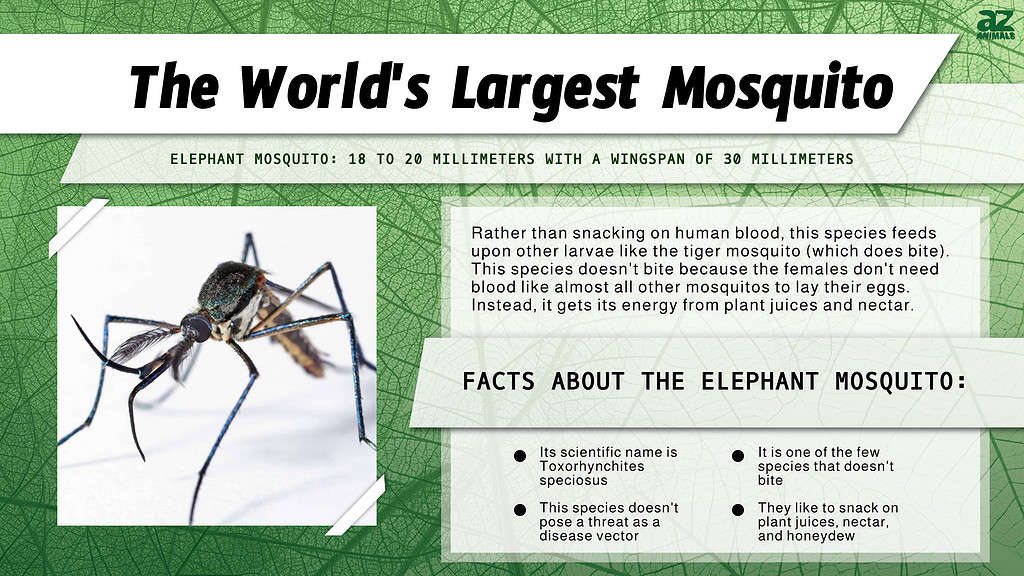
Why Humans Have Nothing to Fear
Toxorhynchites speciosus is one of the few species that don’t bite, even though the sheer size is enough to scare anyone. Rather than snacking on human blood, this species feeds upon other larvae like the tiger mosquito (which does bite). This species doesn’t bite because the females don’t need blood like almost all other mosquitos to lay their eggs. Instead, it gets its energy from plant juices and nectar.
The elephant mosquitos’ relationship with humans is unlike others. In addition to not biting humans, this species doesn’t pose a threat as a disease vector. While in their larvae stage, they also contribute to the balance of aquatic ecosystems by feeding on other larvae, including those disease-carrying species. This natural control of populations is a valuable ecosystem service the elephant mosquito provides.
Physical Characteristics
This elephant mosquito is not only giant but very colorful. They make their presence known with their bright coloration. Members of this family have patterns of blue, gold, green, and white along their legs and bodies. They may appear threatening, but people don’t need to worry because they don’t enjoy human blood. These are allies to humans feeding on the larvae of more aggressive types like the tiger mosquito.
The elephant mosquito poses distinct physical features that set it apart from others. Delicate scales cover its long and slender body, giving it a slightly shiny appearance. Its elongated snout, resembling a miniature elephant’s trunk, is perfectly adapted for feeding on nectar and plant fluids, distinguishing it from its blood-sucking relatives.
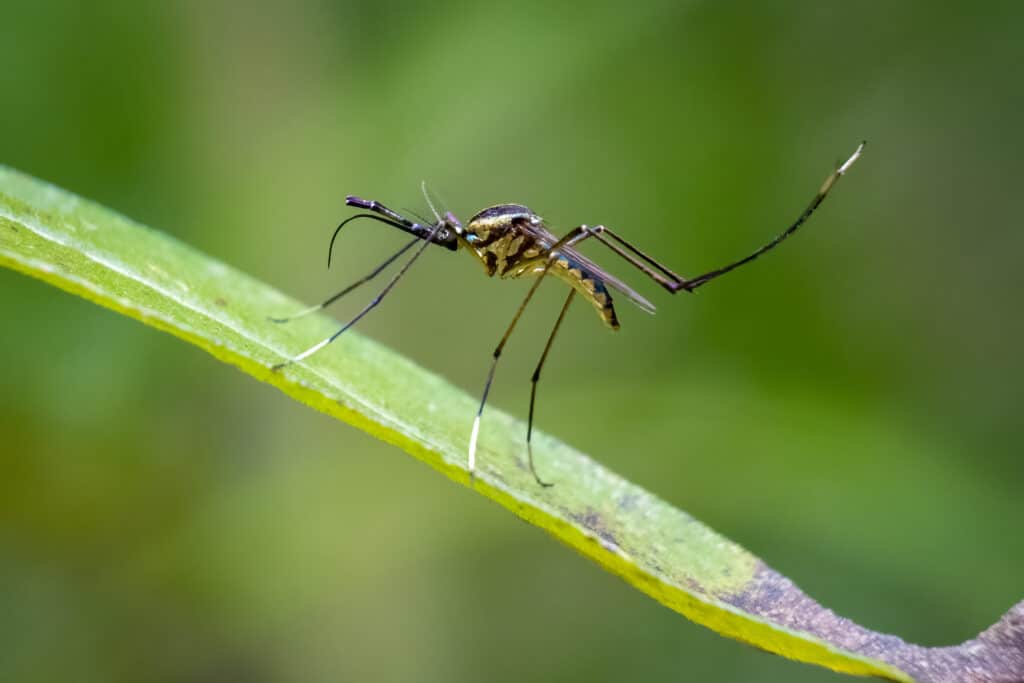
Elephant mosquitoes are most active during the daytime and live in forested warm tropical areas.
©samray/Shutterstock.com
The elephant mosquito, true to its name, surpasses the size of its other counterparts. Unlike the average, which measures 6 to 7 millimeters in length, the elephant mosquito stands out at 18 to 20 millimeters. Its wingspan can reach an impressive 30 millimeters making it an unmistakable presence in the insect world.
Life Cycle and Behavior
The life cycle of the elephant mosquito is similar to that of others. As we said, females lay their eggs in stagnant water like ponds, tree holes, and discarded containers. However, unlike others, they don’t feed on human blood. Instead, they like to snack on plant juices, nectar, and honeydew. This unique dietary preference makes it a valuable pollinator, contributing to the balance of ecosystems it lives in.
Largest Biting Mosquito in the United States, The Gallinipper Mosquito
Scientific name: Psorophora ciliata
In the United States, the Gallinipper mosquito, or Psorophora ciliata, is the most giant-biting mosquito in the United States. The Gallinipper mosquito earns its name with its impressive length, almost the same size as a dime, or with its legs completely stretched out potentially a nickel. Compared to the average mosquito species, which measures about 6-7 millimeters, the Gallinipper can reach a staggering length of 20 to 25 millimeters.
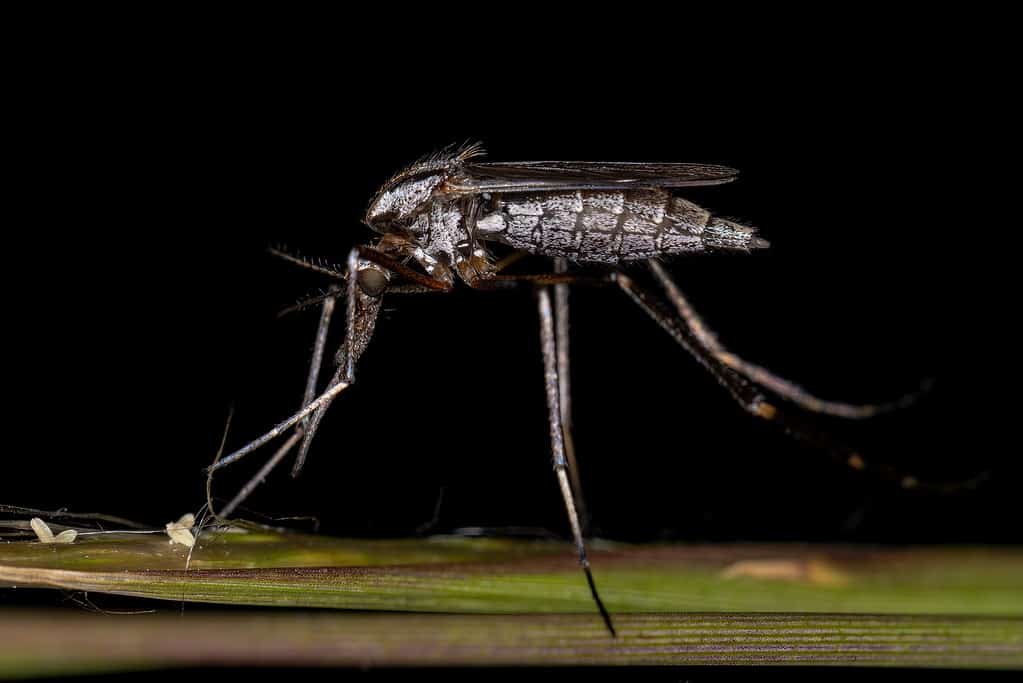
The Gallinipper mosquito will chase you and bite you anytime during the day.
©Vinicius R. Souza/Shutterstock.com
In rural and suburban areas of the eastern United States, the giant mosquito emerges only after a hefty rainfall or flood. Found in states like Florida, Georgia, Louisiana, and Texas. It thrives in moist, low-lying areas like floodplains, swamps, and marshes. These damp habitats provide the conditions for the mosquito’s larval development, which takes place in standing water. It lays eggs in wet Earth, which sit tight until the next deluge.
Life Cycle and Behavior
Like other mosquito species, the Gallinipper mosquito undergoes a complete metamorphosis, progressing through four distinct stages: egg, larva, pupa, and adult. The female Gallinipper is known for her blood-feeding behavior, which is essential for the production of eggs. However, contrary to popular belief, male mosquitos do not bite; they solely feed on plant nectar.
They’re More Aggressive Than Other Mosquitos
The Gallinipper mosquito will chase you and bite you anytime during the day. The blood in humans and other vertebrates contains nutrients critical to their egg development. Because of how significant this mosquito species is, everything about them is on a larger scale. From the amount of saliva injected into the skin to the proboscis (the serrated mouthpart) size to the amount of blood they draw. Expect their bit to be more painful than a typical mosquito bite but milder than a bee sting. Itchiness varies from person to person; if you scratch at common mosquito bites, you can predict your reaction to a giant one.
Most Dangerous Mosquito, Aedes aegypti Mosquito
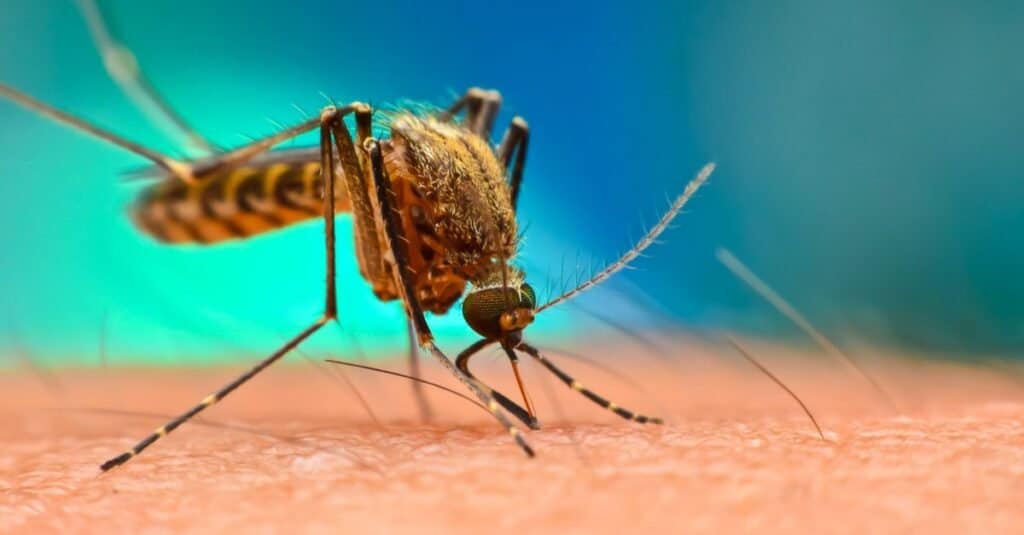
Close-up of Mosquito (
Aedes aegypti)
sucking blood
on human skin.
©Digital Images Studio/Shutterstock.com
The most dangerous mosquito to humans on planet Earth is the Aedes aegypti mosquito. This mosquito is primarily responsible for the transmission of several harmful diseases, including:
- Dengue Fever: A viral infection that can cause severe flu-like symptoms, including high fever, headache, joint and muscle pain, and rash. In certain instances, it can progress into a more severe condition known as dengue hemorrhagic fever, posing a significant risk to one’s life.
- Zika Virus: An illness transmitted by mosquitoes that typically induces mild symptoms in most individuals but poses a significant threat to expectant mothers. Contracting Zika during pregnancy can result in congenital disabilities, such as microcephaly, characterized by an underdeveloped head in newborns.
- Chikungunya: A viral infection characterized by symptoms like high fever, joint and muscle pain, rash, and headache. While rarely fatal, it can cause prolonged joint pain and impact specific individuals’ overall quality of life.
- Yellow Fever: A viral infection with symptoms like fever, jaundice (yellowing of the skin and eyes), muscle pain, and headache.
The Aedes aegypti mosquito is particularly concerning because it thrives in urban environments, bites during the daytime, and can breed in small amounts of stagnant water commonly found in containers around homes. Effective mosquito control measures and personal protection strategies are crucial in areas where this mosquito species is prevalent to reduce the risk of disease transmission.
Fun Facts about Mosquitos
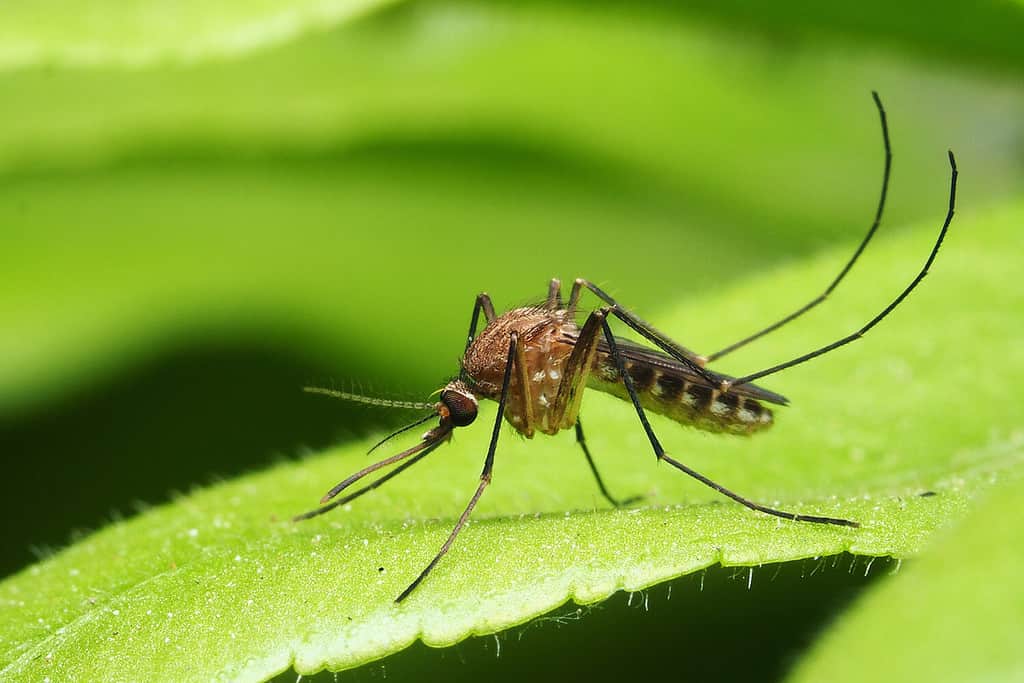
Mosquitos kill more humans than any other animal.
©jiade/Shutterstock.com
- These insects have been around for over 210 million years, making them one of the oldest insect species on Earth.
- You can find skeeters worldwide because they can adapt to various climates and habitats, from arid deserts to tropical rainforests. The only place you won’t find them is Antarctica.
- Only female mosquitos bite. While male and female mosquitos feed on plant nectar, only female mosquitos bite humans and animals. The females require proteins found in the blood to develop and lay their eggs.
- The distinctive buzzing you hear, signaling one is nearby, comes from their wings. Its wings can beat at a frequency of around 450 to 600 times per second.
- Mosquitos are attracted to certain scents, such as carbon dioxide (exhaled breath), lactic acid (sweat), and various body odors. This is why some individuals are more prone to mosquito bites than others.
- These insects have compound eyes that consist of thousands of individual lenses, allowing them to have a wide field of vision. They can detect movement and changes in light patterns.
- While they are notorious for feeding on blood, their primary food source is plant nectar. They play a role in pollination as they visit flowers to get nectar.
- When a female bites, it uses its sharp, elongated mouthpart (proboscis to pierce through the skin and locate a blood vessel. It can complete its feeding in as little as three minutes.
- The average lifespan is relatively short, ranging from a few weeks to a few months, depending on the species. However, some species can survive throughout the winter by hibernating.
- Mosquitos kill more humans than any other animal. This is primarily due to their ability to transmit deadly diseases such as malaria, dengue fever, Zika virus, and West Nile virus.
Tips for Preventing Mosquitos
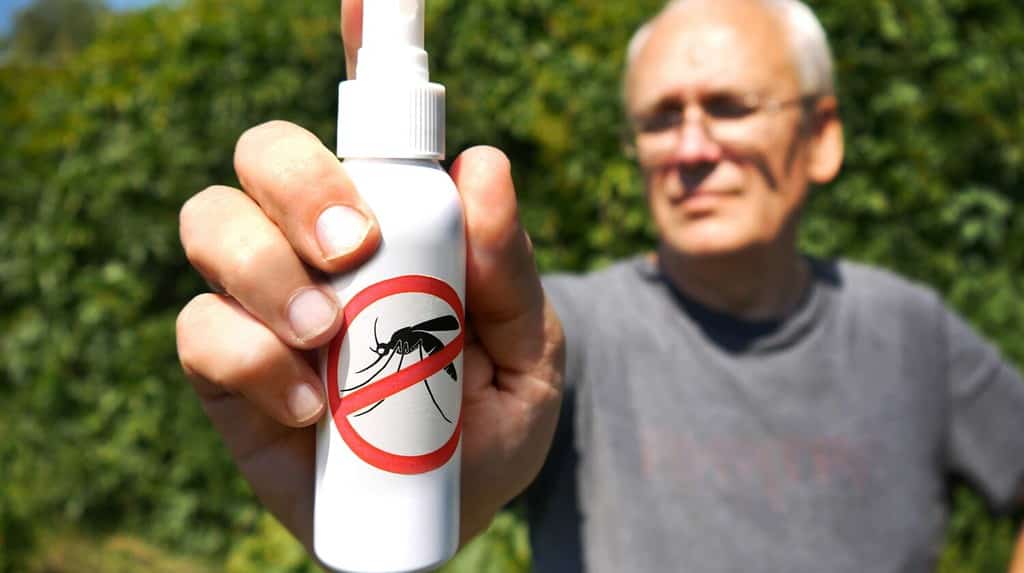
Apply insect repellents containing DEET, picaridin, or oil of lemon eucalyptus on exposed skin when outdoors.
©Stockah/Shutterstock.com
- Remove Standing Water: Mosquitoes breed in stagnant water, so eliminating standing water around your home is essential. Regularly empty and clean containers such as flower pots, buckets, and birdbaths. Ensure that gutters are clean and adequately draining. Fix any leaks or areas where water accumulates.
- Use Mosquito Repellents: Apply insect repellents containing DEET, picaridin, or oil of lemon eucalyptus on exposed skin when outdoors.
- Wear Protective Clothing: In mosquito-prone areas, wear long sleeves, long pants, and socks to reduce exposed skin. Consider wearing light-colored clothing, as mosquitoes are attracted to dark colors.
- Install and Repair Screens: Make sure all windows, doors, and vents have properly fitted screens to keep mosquitoes from entering your home. Repair any holes or tears in existing screens to ensure maximum protection.
- Avoid Peak Mosquito Activity: Mosquitoes are most active during dawn and dusk. Limit outdoor activities during these times or take extra precautions to prevent mosquito bites.
More Tips For Preventing Mosquito Bites
- Create a Mosquito-Unfriendly Yard: Keep your yard well-maintained and trimmed, as mosquitoes like to rest in tall grass and vegetation. Remove debris or items that can hold water, such as old tires or unused containers. Consider using outdoor fans, as mosquitoes are weak fliers and are less likely to approach areas with solid airflow.
- Use Mosquito Nets: When camping or sleeping outdoors, use mosquito nets around beds or sleeping areas to create a physical barrier between you and the mosquitoes.
- Avoid Fragrances: Mosquitoes are attracted to scents, including perfumes, scented soaps, and lotions. Try to avoid using heavily scented products when spending time outdoors.
- Consider Mosquito-Repelling Plants: Some plants, such as citronella, lavender, and marigolds, have natural mosquito-repelling properties. Planting these in your garden or keeping potted versions near outdoor seating areas may help deter mosquitoes.
- Consult Professionals: If you live in an area with a high mosquito population or are concerned about mosquito-borne diseases, seek advice from local health authorities or pest control professionals for additional prevention strategies or treatment options.
Following these preventative measures can significantly reduce mosquito populations and protect yourself from mosquito bites, minimizing the risk of mosquito-borne diseases and ensuring more enjoyable outdoor expert.
What To Do If You Get a Mosquito Bite
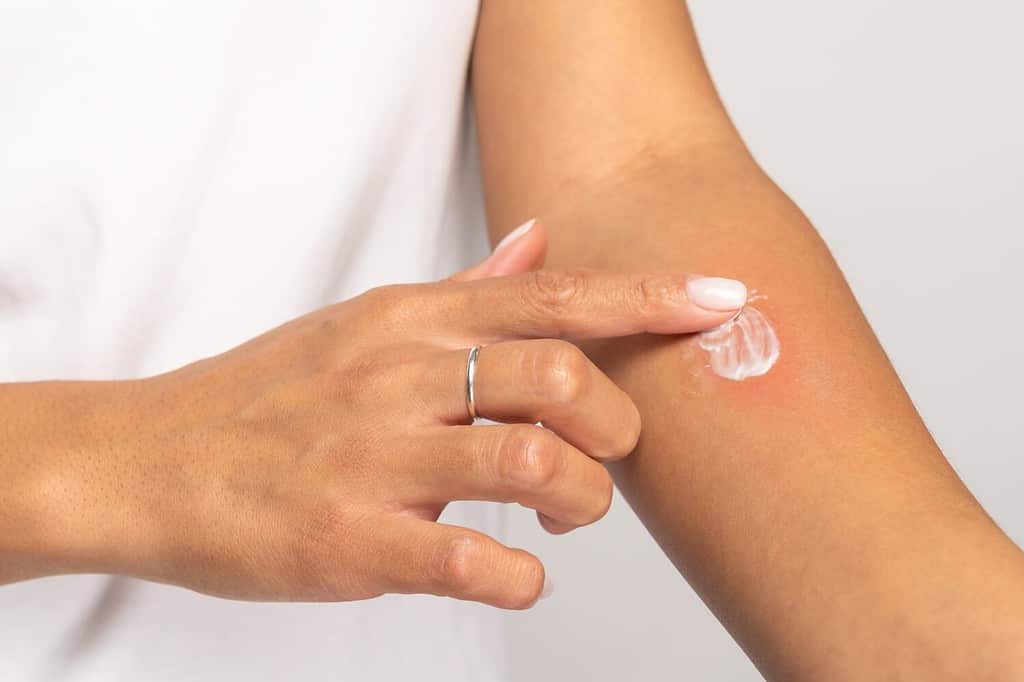
Over-the-counter anti-itch creams or lotions containing ingredients like hydrocortisone, calamine, or menthol can help temporarily relieve itching.
©DimaBerlin/Shutterstock.com
- Avoid Scratching: Although tempting, try to resist scratching the mosquito bite. Scratching can lead to further irritation, increase the risk of infection, and prolong the healing process.
- Clean the Area: Wash the affected area with mild soap and water to cleanse the skin and remove any dirt or bacteria that might be present.
- Apply a Cold Compress: To reduce swelling and relieve itching, apply a cold compress or an ice pack wrapped in a thin cloth to the mosquito bite. Leave it on for about 10 minutes at a time. Avoid direct contact between the ice and your skin to prevent frostbite.
- Use Over-the-Counter Remedies: Over-the-counter anti-itch creams or lotions containing ingredients like hydrocortisone, calamine, or menthol can help temporarily relieve itching. Follow the instructions on the product packaging for proper use.
More Remedies
- Try Natural Remedies: Some natural remedies may help soothe bites. Apply aloe vera gel, witch hazel, or diluted apple cider vinegar to reduce itching and inflammation. Be cautious if you have sensitive skin, and discontinue use if any irritation occurs.
- Take Oral Antihistamines: If the bite causes significant itching or discomfort, you can consider taking oral antihistamines, such as diphenhydramine or cetirizine, as directed by the package or your healthcare provider. These medications can help reduce itching and inflammation.
- Cover the Bite: If you cannot resist scratching, covering the bite with a clean adhesive bandage or a piece of cloth can be a physical barrier and help prevent further irritation.
- Monitor for Signs of Infection: Keep an eye on the bite for any signs of infection, such as increased pain, redness, warmth, or pus. If you notice these symptoms or if the bite becomes increasingly swollen or painful, it’s advisable to seek medical attention.
Remember, mosquito bites are generally harmless and will heal within a few days. However, if you experience severe allergic reactions, persistent itching, or develop symptoms beyond the usual localized response, it’s best to consult a healthcare professional for appropriate evaluation and treatment.
When To Go To The Doctor For a Mosquito Bite
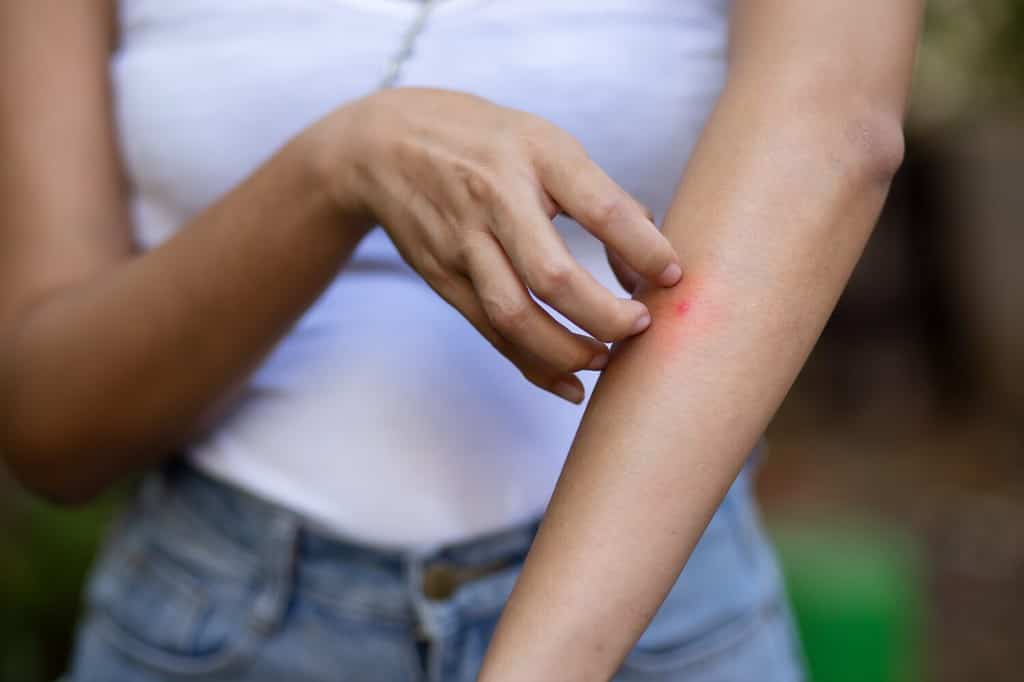
Mosquito bites are usually puffy white or red bumps that itch.
©9nong/Shutterstock.com
- Severe Allergic Reactions: If you experience symptoms of a severe allergic reaction, such as difficulty breathing, swelling of the face, lips, or throat, dizziness, or a rapid heartbeat, seek immediate medical attention. This could indicate an anaphylactic reaction, which is a medical emergency.
- Signs of Infection: If the bite becomes increasingly painful, red, swollen, or warm to the touch, or if there is the presence of pus or increasing tenderness, it may indicate an infection. In such cases, it is advisable to consult a healthcare professional for evaluation and appropriate treatment.
- Development of Systemic Symptoms: If you experience systemic symptoms such as fever, headache, body aches, fatigue, or a general feeling of being unwell after a bite, it may indicate an illness. Seeking medical attention is essential for correctly diagnosing and managing the underlying condition.
- Persistence of Symptoms: If the symptoms from the bite, such as itching, redness, or discomfort, persist for an extended period or worsen despite home care remedies, it may be beneficial to consult a doctor for further evaluation and guidance.
- Travel to High-Risk Areas: If you have recently traveled to an area known for diseases and develop symptoms after a bite, it is advisable to seek medical attention, especially if the symptoms are consistent with those associated with specific illnesses in that region.
The photo featured at the top of this post is © jiade/Shutterstock.com
Thank you for reading! Have some feedback for us? Contact the AZ Animals editorial team.







